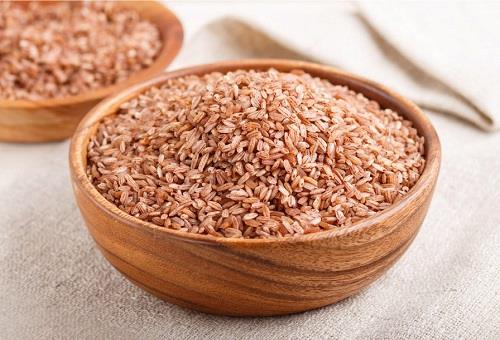Brown Rice: The Secret Weapon for Weight Management

In the world of whole grains, brown rice stands out as a nutritional powerhouse, offering a wealth of health benefits, particularly in the context of weight management. Unlike its refined counterpart, white rice, brown rice retains its bran and germ, the nutrient-rich portions of the grain that are stripped away during processing. This preservation of these essential components makes brown rice a true superfood, packing a punch of vitamins, minerals, fiber, and antioxidants.
White Rice vs. Brown Rice: A Tale of Two Grains
White rice, the staple grain in many cultures, has undergone extensive processing, removing the bran and germ, leaving behind primarily starchy carbohydrates. This processing depletes white rice of its essential nutrients, such as fiber, vitamins, and minerals. While white rice provides energy, its lack of fiber can lead to blood sugar spikes and crashes, contributing to weight gain and overall health issues.
In contrast, brown rice emerges from the processing mill with its bran and germ intact, preserving its nutritional goodness. This whole grain treasure trove provides an array of health benefits, including:
High Fiber Content: Brown rice is a rich source of dietary fiber, an essential nutrient that promotes satiety, aiding in weight management. Fiber slows down digestion, keeping you feeling fuller for longer, reducing overall calorie intake.
Low Glycemic Index (GI): Brown rice has a low GI, meaning it releases glucose into the bloodstream slowly, preventing blood sugar spikes and crashes. This stable blood sugar response helps regulate appetite and promotes weight management.
Nutrient-Rich Composition: Brown rice is packed with essential nutrients, including vitamins B1, B6, and E, as well as minerals such as magnesium, iron, and zinc. These nutrients play crucial roles in various bodily functions, from energy production to immune system support.
Scientific Evidence Supporting Brown Rice’s Role in Weight Management
Numerous studies have demonstrated the positive impact of brown rice consumption on weight management. Here are some notable examples:
A study published in the “Journal of the American Dietetic Association” found that individuals who replaced white rice with brown rice in their diet lost significantly more weight and body fat compared to those who continued consuming white rice.
A study published in the “Journal of Obesity” found that individuals who consumed brown rice as part of a weight loss diet had a lower risk of regaining lost weight compared to those who consumed white rice.
A study published in the “International Journal of Obesity” found that individuals who consumed brown rice had a lower body mass index (BMI) and waist circumference compared to those who consumed white rice.
Expert Opinions on Brown Rice’s Role in Weight Management
Renowned nutrition experts have endorsed brown rice as an effective tool for weight management:
“Brown rice is an excellent choice for weight management due to its high fiber content and low glycemic index.” – Dr. David Jenkins, University of Toronto
“Replacing white rice with brown rice can be a simple yet effective way to boost your weight loss efforts.” – Dr. Marion Nestle, University of California, Berkeley
“Brown rice is a versatile grain that can be incorporated into a variety of healthy weight management diets.” – Dr. Walter Willett, Harvard T.H. Chan School of Public Health
Embracing Brown Rice: A Taste Bud Journey
For those accustomed to the refined flavor of white rice, transitioning to brown rice may seem like a daunting task. However, with a few simple strategies, you can gradually introduce your taste buds to the nutty, earthy notes of brown rice and reap its numerous health benefits.
Gradual Introduction: Instead of an abrupt switch, gradually introduce brown rice into your diet. Start by mixing brown rice with white rice, increasing the proportion of brown rice over time. This allows your taste buds to adapt to the new flavor without overwhelming them.
Flavorful Combinations: Partner brown rice with flavorful ingredients to enhance its taste. Pair it with aromatic spices, herbs, and umami-rich ingredients like tamari, miso, or soy sauce. These additions can mask the subtle differences in flavor between brown and white rice.
Cooking Techniques: Proper cooking techniques can significantly improve the texture and flavor of brown rice. Use the correct water-to-rice ratio, and ensure the rice is cooked until tender but not mushy. Experiment with different cooking methods, such as stovetop, rice cooker, or oven steaming, to find your preferred texture.
Variety and Exploration: Explore different varieties of brown rice, each with its unique flavor profile. Basmati brown rice offers a delicate, fragrant flavor, while black rice delivers a nutty, earthy taste. Discover the variety that suits your palate and experiment with different recipes.
Experts suggestion about consuming brown rice daily:
Consuming brown rice daily is generally considered safe and beneficial for most people. Brown rice is a whole grain that is packed with nutrients, including fiber, vitamins, and minerals. It is a low-glycemic index (GI) food, which means it releases glucose into the bloodstream slowly, helping to regulate blood sugar levels. Brown rice is also a good source of fiber, which can promote satiety and help with weight management.
According to the USDA, adults should aim to consume at least 16 grams of fiber per 1,000 calories per day. A cooked cup of brown rice contains about 3 grams of fiber, so you can easily meet your daily recommended intake of fiber by consuming brown rice daily.
Here are some additional benefits of consuming brown rice daily:
- May help to reduce the risk of heart disease
- May help to reduce the risk of type 2 diabetes
- May help to improve gut health
- May help to boost energy levels
- May help to improve sleep quality
Of course, there are some potential risks associated with consuming brown rice daily:
- Brown rice contains arsenic, a naturally occurring toxin that can be harmful in high doses. However, the amount of arsenic in brown rice is typically not high enough to cause harm.
- Brown rice is also a good source of phytic acid, which can interfere with the absorption of iron and zinc. However, soaking or sprouting brown rice can help to reduce the amount of phytic acid.
Overall, the benefits of consuming brown rice daily outweigh the risks. If you are concerned about the risks of consuming brown rice daily, you can talk to your doctor.
Embracing Brown Rice for a Healthier You
As we conclude our exploration of brown rice, its nutritional prowess, and its role in weight management, it’s evident that this whole grain powerhouse deserves a prominent place in our diets. Brown rice, with its high fiber content, low glycemic index, and abundance of essential nutrients, offers a multitude of health benefits, making it an excellent choice for those seeking a healthier lifestyle.
Transitioning from white rice to brown rice may seem daunting, but with gradual introduction, flavorful combinations, and experimentation with different cooking techniques, your taste buds will adapt to the subtle nutty, earthy notes of brown rice. Embrace the culinary versatility of brown rice and discover its endless possibilities, from salads and stir-fries to pilafs and even sweet treats.
Brown rice is more than just a grain; it’s a nutritional powerhouse that can transform your health journey. Embark on this journey today and experience the remarkable benefits of brown rice for weight management, overall well-being, and a healthier, happier you.








